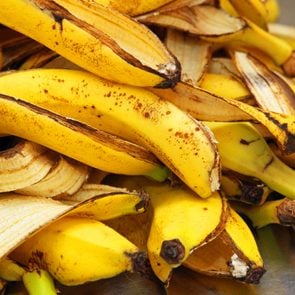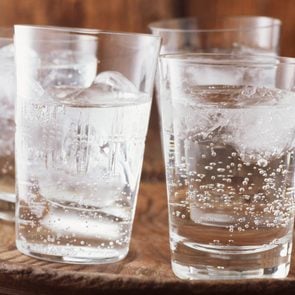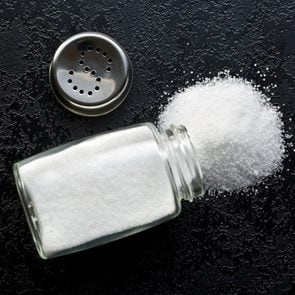What Is Burrata—and What Makes This Cheese So Creamy?
Updated: Dec. 08, 2023

What exactly is burrata? This creamy, buttery Italian cheese is heaven on a plate—or sandwich or salad or pizza.
If you’ve been to an Italian restaurant or ordered an artisan pizza recently, you’ve probably seen burrata on the menu. It wasn’t too long ago that this semi-soft cheese was relatively unknown in the U.S. and found only in specialty cheese shops or Italian groceries. Now, it’s a certified phenomenon, on the list of favorite cheeses for many Americans and headlining menus across the country. And if you’ve ever tasted burrata, you know why! Still asking yourself “What is burrata?” We’ve got the food facts you’re looking for.
Unlike those wondering what’s in American cheese or why Swiss cheese has holes in it, people curious about burrata are likely seeing its popularity unfold in real time. This insanely creamy Italian cheese (creamier than the Midwest favorite cheese curds) is ultra fresh and can be confused with mozzarella. As for the taste, it’s like a little piece of heaven on a plate—or sandwich, or salad, or pizza. Here’s what you need to know about burrata cheese.
What is burrata, exactly?
It’s a type of fresh Italian cheese made from a combination of mozzarella and cream. The outer layer is a thin shell of mozzarella, while the inside is filled with a mixture of mozzarella and cream, giving it a rich, creamy flavor. It’s part of the pasta filata—or stretched curd—family of cheeses.
“Burrata was first created in the 1950s, in the southern Italian region of Apulia,” says Shannon Berry, a cheese specialist for the Dairy Farmers of Wisconsin. “A small farm, known for its mozzarella, tried to find a way to repurpose unused scraps of mozzarella—and just like that, burrata was born.” Like macchiatos and gelato, it’s one of the many foods invented in Italy and adored around the world.
How is burrata made?
“Stretched curd cheeses are made by heating curds in hot water and literally stretching them,” says Caitlin O’Connor, head cheesemonger at The Wine Source in Baltimore. Cheese curds are stretched, kneaded and molded in 150-degree water until they become a firm pliable sheet of mozzarella. Next, the cheese “skin” is stretched into a pouch and filled with a mixture of loose mozzarella curds that have been mixed with cream. Finally, the burrata is cinched, spun and sealed, resulting in a little blob of delicious cheese with a gooey, creamy center. “It’s essentially mozzarella that gets filled with cream and stracciatella (shreds of curd), so it’s creamier and richer than mozzarella,” O’Connor says.
What does burrata taste like?
There’s a reason this Italian cheese has exploded in popularity, even if people still wonder “What is burrata?” It has a rich, milky, buttery and sometimes salty flavor (not considered umami) and tastes just like mozzarella, but with a creamy inside texture that puts it over the top.
“Burrata is like a cheesy dumpling where the wrapper is cheese and the filling is … also cheese,” says Berry. “Slicing into burrata is like slicing into a perfectly runny egg. The outside is a delicate mozzarella, and the inside is filled with more mozzarella and cream. It’s a delicate, rich and creamy cheese that’s a sensory experience in and of itself.”
What’s the best way to eat burrata?
Burrata can be eaten on its own (uncooked), with a side of crusty bread, salt and a light drizzle of high-quality olive oil. It’s also a nice cheese to cook with, and it melts well as a pizza topping.
“Since it is so closely related to mozzarella, it can be used in similar fashions, like melted into pasta or paired with fresh tomatoes,” O’Connor says. “It also goes well topped on a salad or a nice savory soup—French onion would be a great choice.”
What’s the difference between burrata and mozzarella?
You might be able to showcase your culinary smarts with this food quiz, but are you able to correctly differentiate between these cheeses? “At first glance, both of these cheeses can look quite similar—after all, they’re both beautiful balls of fresh cheese,” Berry says. “Burrata is made of mozzarella cheese but formed into a pouch and filled with fresh cheese curds and cream. Because of the additional cream, it’s richer and more flavorful than mozzarella.”
Can you eat the “skin” of burrata?
Eating the “skin” is the whole point! The outside (or skin) of burrata is just firm mozzarella, and the inside is shredded cheese mixed with cream. It should all be eaten together.
Is burrata healthy?
What is burrata like from a health standpoint? Like most cheeses, it’s high in fat and calories, so it should be consumed in moderation as part of a balanced diet. It is also a good source of protein and calcium. However, it is a less healthy option than some other types of cheese, such as crumbly feta or goat cheese, which tend to be lower in fat and calories.
Sources:
- Shannon Berry, cheese specialist for the Dairy Farmers of Wisconsin
- Caitlin O’Connor, cheesemonger at The Wine Source in Baltimore






















